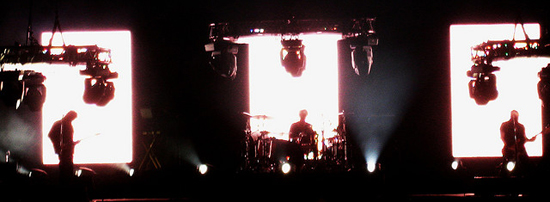
City Sounds: Buenos Aires
01 June, 2011Like every other big city in the world, there is a musicality that oozes from the streets of Buenos Aires. The incessant humming of old, rusty buses trying to make their way through cobbled roads, explosive symphonies of taxi horns alerting pedestrians not to cross a corner, choirs with half-covered faces singing political slogans in the middle of an avenue.
As the main entry port to the country, Buenos Aires received millions of European immigrants from the late nineteenth century until the mid-twentieth century. The result is a patchwork of ethnicities that have left their mark in the very entrails of the city.
The perpetual melancholic mood that surrounds the city sets the perfect background for tango. Tango is ultimately based on sadness: from the pain caused by unrequited love to that of a loved one gone. Discépolo – one of the greatest poets of tango that wrote a magnificent social commentary in “Cambalache” – defined it as a ‘sad feeling that is danced’.
Despite its present regard as a sophisticated music style, Tango started out as a popular dance and, as such, included the way in which the working-class used to speak. Lunfardo is a very porteño – as Buenos Aires-born people are known – way of speaking in which words from other languages were adapted to Spanish (e.g. the Italian verb lavorare –to work- turned into laburar). Vesre, a part of Lunfardo, turns the syllables that form a word around. For example mujer (Spanish for woman) changes into jermu. Even now, in twenty-first century Buenos Aires, people keep using this slang.
The revival that tango experienced in the last few years put it in the spotlight again. Tango academies, tanguerias and specialised shoe and costume shops swarm the streets of Buenos Aires city centre.
Tango’s adaptability meant it was able to adjust to the newest music trends in order to attract the younger generations. It rapidly evolved into electronic tango, a very successful mix that spread all around the world and that can be heard as background music of TV news and spots alike. It is not uncommon to dance this appealing fusion of styles at the end of tango classes in modern tanguerias (La Viruta).
The flow of immigrants in the mid-late twentieth century changed its origin to Argentina’s neighbouring countries. Many people from Bolivia and Paraguay, as well as Northern Argentinians, went to Buenos Aires in search of a better future. Unable to find jobs or earn enough money, they built unstable houses in informal settlements. Far from leaving their culture behind them, these new residents brought their love for cumbia to the capital city.
Just like tango, cumbia villera (shanty town cumbia) started as the musical expression of the inhabitants of the poorest parts of the city. Scantly clad women, sex, drugs and violence are the subjects of this style’s lyrics. Although it does have many objectors, they couldn’t prevent it from spreading to other areas of the city. Popular idols, such as footballer Carlos Tévez, formed their own bands gaining more fans from different backgrounds.
Argentina, as well as Uruguay, adopted the Spanish-born murga and adapted it to the local taste and style. The Buenos Aires murga is made up of a large number of percussionists and dancers, who following the beat of drums and the ringing of whistles, put up a rather colourful, sparkly show. The energy level involved in this dance is strenuous, with adults and children jumping, kicking the air and performing stunts. Carnival is their main performance season, although they also play at smaller festivals and special occasions throughout the year. This style became so popular that even rock bands such as Los Fabulosos Cadillacs (“Matador”) and Los Auténticos Decadentes (“El Murguero”) included it in songs that became Argentine folk anthems.
Rock and pop music in Argentina has been in constant blook since the 1960s. The military dictatorship in the 70s, which aimed to control and limit the activity of the youth by means of censorship, kidnappings, torture and murder, caused a massive cultural reaction that found one of its expressions in music. Charly García wrote “Alicia en el País” (Alice in the Land) with his band Serú Girán, in which he skilfully mentioned the dark times Argentina was going through without actually saying anything compromising as, otherwise, the song would have been censored. Luis Alberto Spinetta was also part of this new musical movement that fulfilled a social function.
The 1980s and 1990s broadened the musical spectrum of Buenos Aires with very successful groups that earned followers all over Latin-American, the US and Spain. Sumo (whose leader was Italian-Scottish singer Luca Prodan) introduced songs that were mainly sung in English. Soda Stereo became one of the biggest names of Latin American rock with hit songs such as “De música ligera” and “Persiana Americana”. They played a farewell tour in 1997 which ended with a show in front of 75,000 people at the River Plate Stadium. Soda Stereo’s singer Gustavo Cerati became a thriving solo act with a very glamorous sound. Unfortunately he suffered a stroke after a show in Venezuela in May this year and has been in a coma ever since. Diego Torres and his “Color Esperanza” song (Colour of Hope) became the feel-good track of the 2001 economic crisis.
Just like the city of Buenos Aires itself, its final musical product is a patchwork in which absolutely anything and everything can happen. From punk to blues and glam rock to cumbia Buenos Aires embraces all possible music styles, mixing them, clashing them and producing sounds that are meant to be remembered.
Follow Sounds and Colours: Facebook / Twitter / Instagram / Mixcloud / Soundcloud / Bandcamp
Subscribe to the Sounds and Colours Newsletter for regular updates, news and competitions bringing the best of Latin American culture direct to your Inbox.

